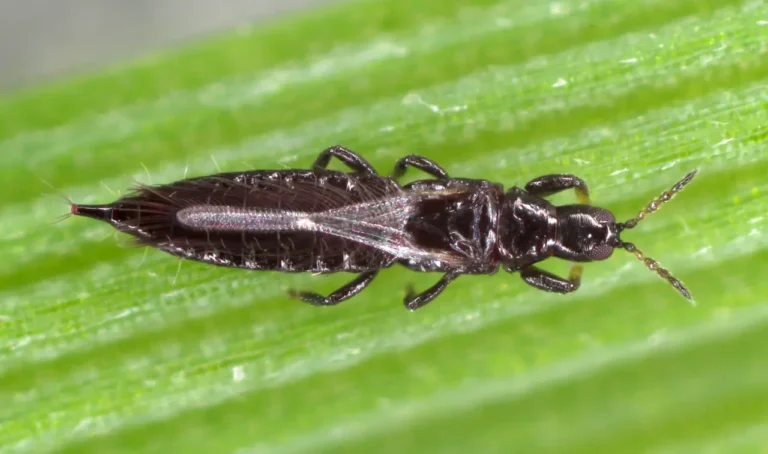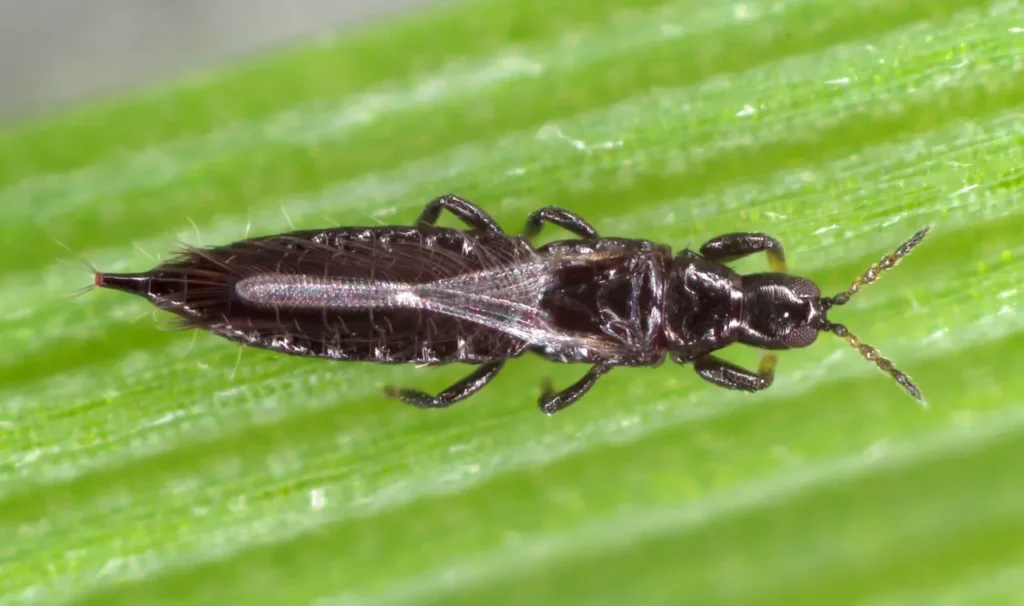Table of Contents
What Are Thrips?
Thrips are tiny, slender insects that belong to the order Thysanoptera. They are often considered pests because they feed on the sap of plants, causing damage to leaves, flowers, and fruits. Thrips have distinctive fringed wings and rasping-sucking mouthparts, which they use to puncture plant tissues and extract the sap.
These pests can cause various problems for plants, including distorted growth, silvering or bronzing of leaves, stippling (tiny white or yellow spots), and even transmitting plant viruses. Thrips are often found on a wide range of plants, including ornamentals, vegetables, and fruits.
Controlling thrips can be challenging due to their small size and ability to reproduce quickly. Integrated pest management (IPM) strategies, including using insecticidal soaps, oils, or other pesticides, along with cultural practices such as pruning and removing infested plant parts, are often employed to manage thrips populations effectively.
6 Types of Thrips
There are many species of thrips that can be found on plants, but some of the most common types include:
Western Flower Thrips (Frankliniella occidentalis): These are one of the most widespread and economically important species of thrips. They feed on a wide range of plants, including vegetables, fruits, and ornamentals.
Onion Thrips (Thrips tabaci): As the name suggests, onion thrips are commonly found on onion crops but can also infest other plants such as garlic, leeks, and chives.
Tobacco Thrips (Frankliniella fusca): These thrips primarily feed on plants in the Solanaceae family, including tobacco, tomatoes, peppers, and eggplants.
Chilli Thrips (Scirtothrips dorsalis): Originally from Asia, chilli thrips have become a significant pest in many tropical and subtropical regions, feeding on a wide range of plants, including peppers, roses, and citrus.
Rose Thrips (Thrips fuscipennis): As the name suggests, these thrips are often found on roses but can also infest other ornamental plants.
Citrus Thrips (Scirtothrips citri): Citrus thrips are a major pest of citrus trees, feeding on leaves, flowers, and fruit, and causing damage to the crop.
These are just a few examples, and there are many other species of thrips that can be found on various plants around the world. Identifying the specific type of thrips infesting a plant can be important for implementing effective control measures.
How to Get Rid of Thrips
Getting rid of thrips on plants can be challenging, but there are several methods you can try to control their population:
Pruning: Remove and destroy heavily infested plant parts, such as leaves, flowers, and buds. This can help reduce the thrips population and prevent them from spreading to other parts of the plant.
Water: Thrips are not strong fliers and are easily dislodged from plants by spraying them with a strong stream of water. Regularly washing plants with water can help reduce thrips numbers.
Insecticidal Soaps and Oils: Use insecticidal soaps or horticultural oils to suffocate and kill thrips. Make sure to thoroughly coat the plant, including the undersides of leaves where thrips often hide.
Neem Oil: Neem oil is a natural insecticide derived from the neem tree. It can disrupt the growth and development of thrips and other pests. Dilute neem oil according to the manufacturer’s instructions and apply it to the affected plants.
Predators and Parasitoids: Introduce natural predators and parasitoids of thrips, such as lacewings, ladybugs, minute pirate bugs, and predatory mites. These beneficial insects can help keep thrips populations in check.
Biological Controls: Certain beneficial microorganisms, such as Beauveria bassiana and Steinernema feltiae, can be applied to the soil to target thrips larvae and pupae.
Chemical Insecticides: As a last resort, chemical insecticides labeled for thrips control can be used. However, be cautious when using pesticides, as they can harm beneficial insects and pollinators. Follow the instructions on the label carefully and avoid using broad-spectrum insecticides that can harm non-target organisms.
Cultural Practices: Implement good cultural practices, such as proper sanitation, removing weeds and debris from around plants, and avoiding overfertilization, as these practices can help reduce thrips habitat and breeding sites.
Combining multiple control methods and regularly monitoring plants for signs of thrips infestation can help effectively manage thrips populations and protect your plants.

6 Harmful Effects of Thrips on Plants
Thrips can have several harmful effects on plants:
Feeding Damage: Thrips feed by puncturing plant tissues and sucking out the sap. This feeding damage can cause leaves to become distorted, discolored, and deformed. Thrips feeding can result in stippling, silvery or bronzed areas, and necrotic lesions on leaves, reducing their photosynthetic capacity and overall plant vigor.
Flower and Fruit Damage: Thrips feeding on flowers and fruits can cause similar damage as on leaves, including discoloration, distortion, and scarring. In severe cases, thrips feeding can lead to premature flower drop, reduced fruit quality, and yield loss.
Transmission of Plant Diseases: Some species of thrips are vectors for plant diseases, including viruses. Thrips can acquire viruses from infected plants during feeding and then transmit them to healthy plants as they feed elsewhere. This can result in the spread of diseases that can cause significant damage or even death to affected plants.
Stress and Reduced Growth: Severe thrips infestations can cause significant stress to plants, leading to stunted growth, reduced vigor, and overall decline in plant health. Plants may also become more susceptible to other pests and diseases due to thrips damage.
Aesthetic Damage: Thrips damage can affect the aesthetic appeal of plants, particularly ornamentals. Disfigured leaves, flowers, and fruits can reduce the visual quality of plants and diminish their ornamental value in landscapes and gardens.
Secondary Infections: Wounds caused by thrips feeding can provide entry points for secondary pathogens such as fungi and bacteria. These secondary infections can further damage plant tissues and exacerbate the negative effects of thrips infestation.
Overall, thrips can cause significant economic losses in agriculture and horticulture by damaging crops, reducing yield and quality, and increasing management costs associated with pest control measures. Effective monitoring and management strategies are essential for minimizing the harmful effects of thrips on plants.
FAQs
What are thrips? Thrips are tiny, slender insects belonging to the order Thysanoptera. They are often considered pests because they feed on the sap of plants, causing damage to leaves, flowers, and fruits.
What do thrips look like? Thrips are very small insects, usually less than 1/20 of an inch in length. They have elongated bodies and distinctive fringed wings. Thrips range in color from pale yellow to dark brown or black.
Where are thrips commonly found? Thrips can be found on a wide range of plants, including vegetables, fruits, ornamentals, and crops. They are often found on the undersides of leaves and in flowers, where they feed on plant sap.
What damage do thrips cause to plants? Thrips feeding can cause various types of damage to plants, including distorted growth, stippling, silvering or bronzing of leaves, and scarring of fruits. Thrips can also transmit plant viruses, leading to diseases in infected plants.
How can I control thrips on my plants? Controlling thrips can be challenging, but several methods can be effective, including pruning infested plant parts, using insecticidal soaps or oils, introducing natural predators and parasitoids, applying biological controls, and, as a last resort, using chemical insecticides.
Are thrips harmful to humans? Thrips are primarily plant pests and are not known to cause harm to humans directly. However, some people may experience skin irritation or allergic reactions when in contact with thrips or their saliva.
How can I prevent thrips infestations? To prevent thrips infestations, practice good garden hygiene by removing weeds and debris from around plants, avoid overfertilizing, and encourage biodiversity in your garden to support natural predators of thrips.
What plants are most susceptible to thrips? Thrips can infest a wide range of plants, but some plants are more susceptible than others. Common hosts include roses, onions, peppers, tomatoes, citrus, and various ornamental flowers and shrubs.
Do thrips have a seasonal cycle? Thrips populations can vary throughout the year and may be influenced by factors such as temperature, humidity, and plant availability. In warmer climates, thrips may be active year-round, while in cooler regions, they may be more active during the warmer months.
Can thrips be beneficial? While most thrips are considered pests, some species can be beneficial as natural predators of other pests, such as mites and small insects. However, these beneficial thrips are typically not as common or well-known as pest species.
Share this post:




